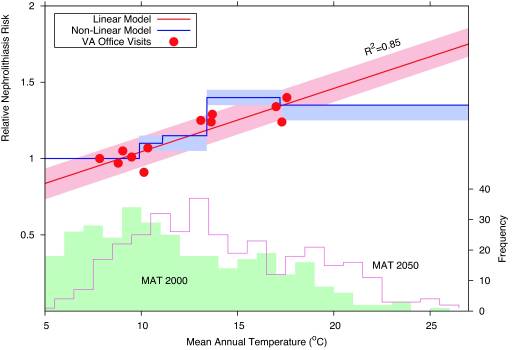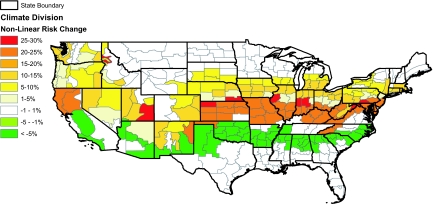Introduction
Researchers in the United States have found that in northern America occurrences of kidney stones might become common with climatic changes. Incidences of kidney stones are higher in areas having warmer climates. (Trinchieri 2000) The main reason for this has been presumed to be that with the rise in the temperature, loss of fluid takes place in the warmer areas causing kidney stones. Researchers have also found that by the year 2050 kidney stone incidences all over the United States may even go up by more than 30% in the warmer areas thus, leading to an additional 1.5 million to 2.1 million cases of kidney stone. (Canadell 2007) This is a direct result of global warming that has been increasingly causing serious medical consequences in human beings.
Kidney stone and its relation between climate change
Kidney stone is a common disease in humans and they are solid crystals that are generated when minerals get dissolved in our urine. Kidney stone is normally caused due to metabolic or environmental problems in cases where the risk of stone formation is directly increased with lower volumes of urine since there is an increase in the concentration of the mineral salts that form the stone. This normally occurs when our body does not receive enough fluids daily or when the body starts to lose fluids very fast, eventually leading to dehydration. Most of these solid crystals or stones formed are small almost like a grain of sand, and thus easily pass through our kidneys. (Lotan 2002) But sometimes the larger crystals get trapped in our ureter, which is a tube between our bladder and kidney, thus blocking the normal flow of our urine. Thus, it is often recommended by urologists that to stop the creation of kidney stones, one must drink a lot of water so that all the minerals in our body get flushed out. When a kidney stone passes through our body we feel unbearable pain along with vomiting, blood in our urine, and nausea. As the temperature increases, the body receives lesser fluids due to which the urine levels get low, due to dehydration, directly increasing the risk of the creation of kidney stones. (Chen 2000)
Kidney stone which is a general human affliction has a lifetime prevalence of 7% in women and 12 % in men of the United States. The southeastern parts of the United States have been found to have a 50% greater prevalence rate of the formation of kidney stones than the northwestern parts. The mean annual temperature or MAT of an area has been found to greatly influence our body’s urine volume and fluid status and accounts for more than 70% of this changeability, while the rest is due to sunlight index, race, age, diuretic use, and gender. (Lotan 2007)The MAT in the southeastern regions of the United States is 8°C more than in the northwestern regions. Also in the United States, there has been a 3.6% to 5.2% increase in the occurrence of kidney stones between the periods of 1976 to 1980 and 1988 to 1994. (Robertson et. al. 2001) Between these 2 given periods, the MAT in the United States had increased by almost 0.5°C. Thus this, although it doesn’t completely prove the fact, suggests a potential relationship between an increase in the occurrence of kidney stones and temperature changes. (Mandel 2001)
Kidney stone belt and effect of climatic change on it
Transient variations in the occurrence of kidney stones as seen in seasonal periodicity are also one of the reasons causing temperature changes. Our body’s psychological response time for the changes in the climate is very rapid and thus, in arid and hot climatic areas kidney stones can develop almost within 90 days. Researchers have predicted that global warming will take place in this century thus, significantly increasing the MAT as well in the United States. (National Climatic Data Center 2006) Currently, the kidney stone belt primarily comprises the warmer southeastern areas of Alabama, Tennessee, Arkansas, South Carolina, Florida, Mississippi, Georgia, North Carolina, and Louisiana, but as the temperature rises there will be more occurrences of kidney stones and the belt will expand towards the northern and western areas as a direct result of global warming. (Elliott et. al. 2001) Due to this, the largest increase in the occurrences of kidney stones may be found in Florida, Texas, and California. But this will happen if the temperature increases linearly. If a threshold takes place then the occurrences of kidney stones will increase drastically resulting in the formation of a new kidney stone belt which will stretch right from Kansas to Northern California and Kentucky. (Cramer 2006) It has been predicted that the percentage of people in the United States that live in high-risk zones of occurrences of kidney stones will increase from almost 40% in 2000 to 70% in 2095 and 56% in 2050. (Pearle 2001)
Rise in cost for treating kidney stone
By using the climate models of intermediary severity warming, researchers have predicted that a rise in the temperature will increase the occurrences of kidney stones due to which the associated increase in the costs for treating kidney stones will also increase by almost $1 billion to $1.13 million every year. This is almost a 25% increase over the current expenditure that is being currently spent in the United States for treating kidney stones. (Bateson 2003)
Results

The projected warming is given in the above figure by the histograms and the top lines represent 2 temperature response models distinctly indicating the increased risk of kidney stones. From the above, we can see that the distribution of the occurrences of kidney stones that are related to climatic changes depends strongly on the pattern of the given temperature dependence model. Since, in the given linear model the increased risk of kidney stone reckons upon the rise in the temperature and baseline risk, the increased risk is focused more in the western areas and towards the mid-continent. (IPCC4 2007) The non-linear risk model displays sharp temperature dependence. According to this model, a steep rate of increase in the occurrences of kidney stones will be experienced between the temperatures of 10°C and 15°C, (Chen 2008) that is the threshold value with a smaller risk of kidney stone occurrences above these temperatures. As a result, according to this model, there will be little change in the occurrences of kidney stones that has been predicted in the areas with a 13.4°C temperature rise in 2050. (Evans 2005) This area has been represented by the red area in the figure given below and it trails the movement of threshold isotherm towards the north. Although the overall effect as predicted by this non-linear model is quite similar to that of the linear model since according to both the present high-risk zone of the kidney stone belt in the southeastern region of the United States will probably expand northward including the states from Kansas to North Carolina and Virginia, the increase in the occurrences of kidney stone will be sharply concentrated in the areas that are immediately situated south of threshold isotherm. (Pearle 2005)

Conclusion
From the above two models, we have enough evidence to sketch out a possible relation between the increased occurrence of kidney stones with the temperature rise, taking the example of the United States. However, from the above-given pieces of evidence, the specific relationships among these 2 factors have not been precisely elucidated. One of the possible reasons for this could be that the occurrence of kidney stones increases with a temperature rise may be suddenly at the threshold value till a point is encountered where the occurrences either plateaus out or even decrease, as given by the non-linear model. (Saigal 2005) Then again occurrences of kidney stones may continually increase with the temperature rise, as given by the linear model. Also increased occurrences of climate-related formation of kidney stones and their impact on the population of the United States will be more or less non-uniformly distributed. According to the linear model, the impact will be concentrated on the southern parts of the United States while the non-linear model predicts concentration in the upper mid-western parts. Researchers have also predicted that kidney stone belts all over the world will be affected similarly, although the impact of the occurrences will be much greater in the developing countries adding a new challenge to the demanding task of conforming to the climatic changes of this century. (Tanser 2003)
Bibliography
Bateson EM. (2003) ‘Renal tract calculi and climate’, Med J Aust, vol. 2, pp. 111–113.
Brikowski T, Lotan Y. ( 2007) A Painful Truth: Climate Change Will Increase Kidney Stone Disease, Denver, CO: Geol Soc America.
Canadell, JG. (2007) ‘Contributions to accelerating atmospheric CO2 growth from economic activity, carbon intensity, and efficiency of natural sinks’, Proc Nat Acad Sci USA, vol. 3, no. 7, pp. 98-104.
Chen Y-K, Roseman JM, DeVivo MJ, Huang C-T. (2000) ‘Geographic variation and environmental risk factors for the incidence of initial kidney stones in patients with spinal cord injury’ J Urol, vol. 16, no. 4, pp. 21–26.
Chen Y-K, Lin H-C, Chen C-S, Yeh S-D. (2008) ‘Seasonal variations in urinary calculi attacks and their association with climate: A population-based study’, J Urol, vol. 17, no. 9, pp. 564–569.
Cramer JS, Forrest K. (2006) ‘Renal lithiasis: Addressing the risks of austere desert deployments’, Aviation Space Environ Med, vol. 77, no. 3, pp. 649–653.
Dirks J, Remuzzi G, Horton S, Schieppati A, Rizvi S. (2006) Diseases of the Kidney and the Urinary System. 2nd Ed. New York: Oxford Univ Press.
Elliott JP, Jr, Gordon JO, Evans JW, Platt L. (2001) ‘A stone season: A 10-year retrospective study of 768 surgical stone cases with respect to seasonal variation’, J Urol. Vol. 11, no. 4, pp. 574–577.
Evans K, Costabile RA. (2005) ‘Time to development of symptomatic urinary calculi in a high-risk environment’, J Urol, vol. 17, no. 3, pp. 858–861.
IPCC4. (2007) Climate Change 2007: The Physical Science Basis, Summary for Policymakers, Fourth Climate Assessment Report, Geneva: UN Intergovernmental Panel on Climate Change.
Lotan, Y. (2002) ‘Management of ureteral calculi: A cost comparison and decision making analysis’, J Urol, vol. 164, pp. 1621–1629.
Lotan, Y. (2007) ‘Cost-effectiveness of medical management strategies for nephrolithiasis’ Proc Nat Acad Sci USA, vol. 17, no. 2, pp. 2275–2281.
Mandel, GS. (2001) ‘Urinary-tract stone disease in the United States veteran population. Geographical frequency of occurrence’, J Urol, vol. 14, no. 2, pp. 1513–1515.
National Climatic Data Center. (2006) US Heat Stress Index Data: Technical Report, Asheville, NC: National Oceanic and Atmospheric Administration.
Pearle MS, Calhoun EA, Curhan GC. (2005) ‘Urologic Diseases in America project: Urolithiasis’, J Urol, vol. 17, no. 3, pp. 848–857.
Pearle, MS. (2001) ‘Meta-analysis of randomized trials for medical prevention of calcium oxalate nephrolithiasis’, J Endourol, Vol. 13, pp. 679–685.
Robertson WG, Peacock M, Marshall RW, Speed R, Nordin BE. (2001) ‘Seasonal variations in the composition of urine in relation to calcium stone-formation’, Clin Sci Mol Med, vol. 4, no. 9, pp. 597–602.
Saigal CS, Joyce G, Timilsina AR. (2005) ‘Urologic Diseases in America Project. Direct and indirect costs of nephrolithiasis in an employed population: Opportunity for disease management?’ Kidney Int,; vol. 6, no. 8, pp. 1808–1814.
Trinchieri A. (2000) ‘Increase in the prevalence of symptomatic upper urinary tract stones during the past 10 years’, Eur Urol. Vol. 3, no. 7, pp. 23–25.
Tanser FC, Sharp B, le Seur D. (2003) ‘Potential effect of climate change on malaria transmission in Africa’, Lancet, vol. 36, no. 2, pp. 1792–1798.